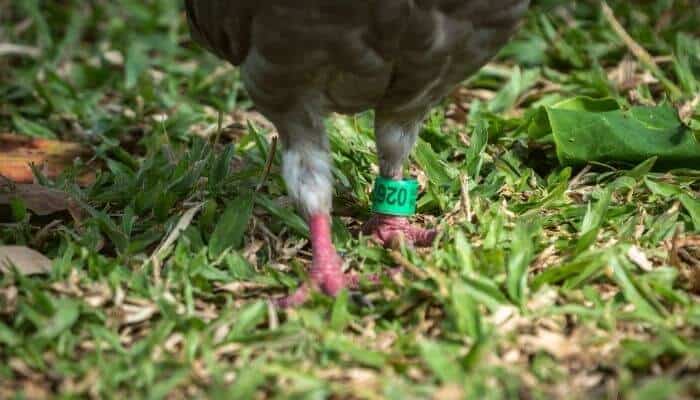The tags you see on pigeons’ feet is known as ‘ringing’ or ‘pigeon banding’.
They are an attempt by ornithologists to gain information about the birds.

There is a worldwide scientific movement to learn more about the avian species, including pigeons, which inhabit our planet.
The rings serve as an individual identification for the bird with their unique number and usually with a contact number.
Pigeons are captured and before being ringed their vital statistics are recorded.
This covers such things as:
- age
- weight
- sex
- general health condition
- location of their capture
The birds are released unharmed and the information is fed into the organization’s database.
The contact number is so that other bird watchers can call in the bird’s location if found or recaptured.
It is also hoped that if someone from the general public finds a dead and ringed pigeon they will be good enough to pass along the information.
The Purpose Of Pigeon Tags
The purpose of ringing pigeons is to build up a picture of their movements and behavior.
This is done all over the world with migratory species, to track their routes, identify the habitats that they use, feeding or mating habits and so on.
Side note: in more recent years digital pigeon trackers have taken the racing pigeon world by storm, they allow pigeon fanciers to digitally record exactly where their pigeon goes, how fast they fly and their altitude which can then be downloaded, viewed and analyzed once they return.
Although pigeons don’t migrate, they may move from one location to another.
Ornithologists and scientific researchers who study avian species use the rings to monitor flock movements and determine why a bird or flock may relocate or why an individual pigeon is out of its normal environment.
The answers may include food resources, danger, sickness, climate change or human activity.
The more data that they can compile, the greater help it is in understanding the behavior and condition of feral pigeon populations
Ancient Times
Pigeons have been used as a means of communication since ancient times, but the first records of tagging birds appear in Roman times.
This was merely a question of marking property than anything else.
The same sort of marking or tagging crops up again during the Middle Ages, when falconry was popular.
Falconers would mark their birds so that they could be easily identified and not stolen.
Many homing pigeons are ringed as well for identification by their owners.
Although it doesn’t happen very often, some racing/homing pigeons can get lost due to extreme weather conditions.
If found later, they can be returned to their home lofts thanks to the info on the tag.
The Start Of Pigeon Tagging
In our modern era, the first attempt at tagging for the purpose of scientific study was made by an amateur Danish ornithologist back in 1899.
At first he used zinc rings, which were too heavy, but finally settled on aluminum.
Not only were they light enough not to impede the birds, but were also non-corrosive.
Nowadays, with the use of plastic, the rings are lighter still and much tougher.
More organized and officially sanctioned attempts at mass ringing took place in Germany in 1903 at the Rossitten Bird Observatory and the U.S.A. in 1902.
Many European countries followed suit through various different avian study organizations and research centers.
Ornithologists all over the world now use this method to gain information about bird populations and ringing campaigns are organized by nationally recognized agencies and organizations.
Summary
Now you know that pigeons tag are part of an ongoing scientific endeavor to collect data about these wonderful birds.
The more we study the habits and behavior of the animals that we share our planet with, the more we will understand our world and our place in it.
